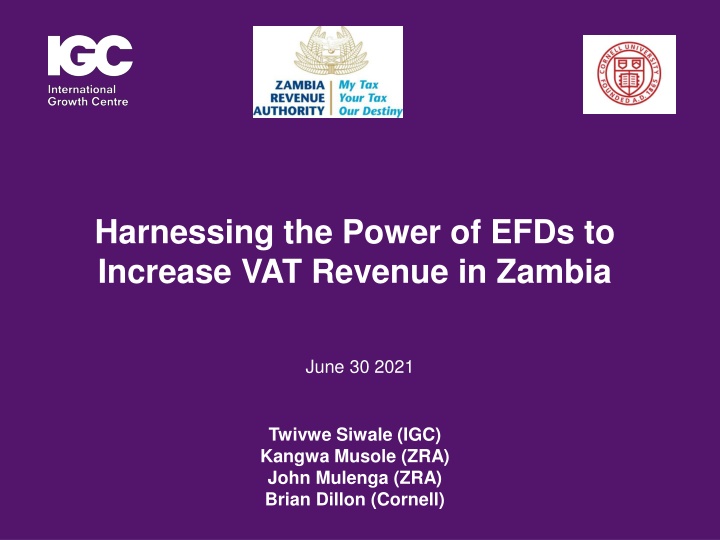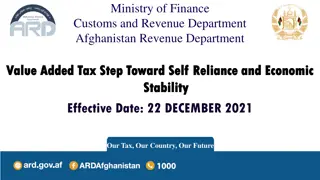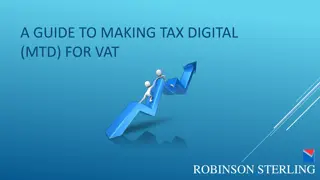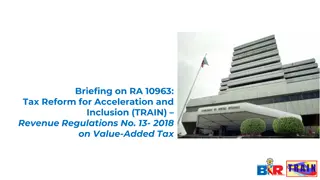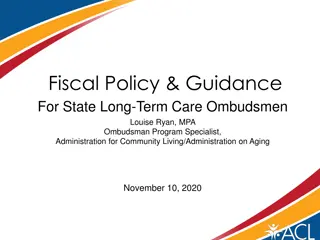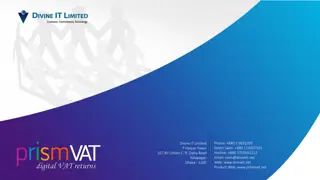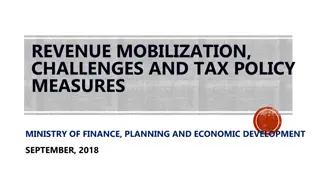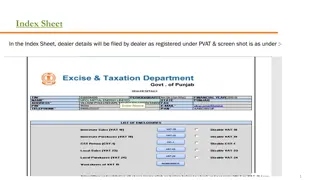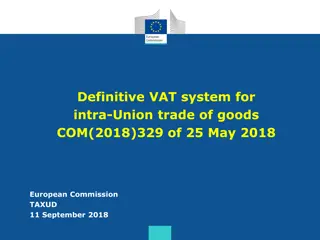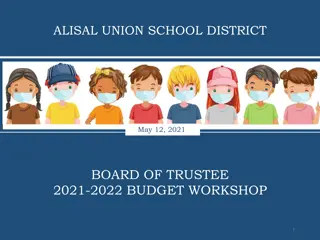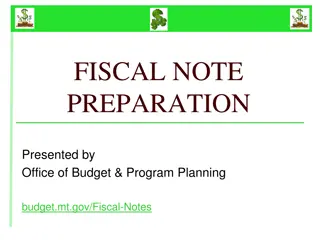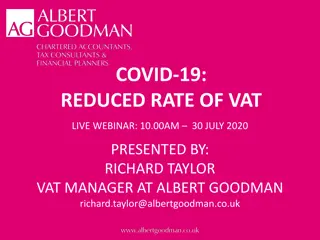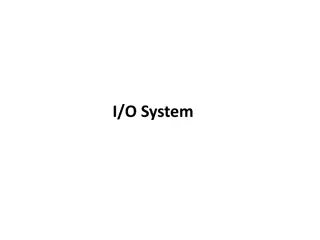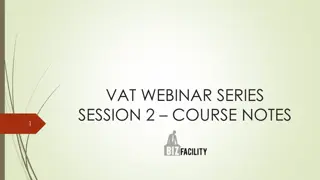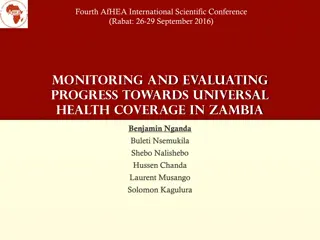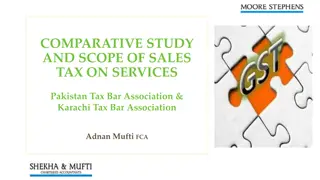Enhancing VAT Revenue in Zambia through Electronic Fiscal Devices
Analyzing the impact of Electronic Fiscal Devices (EFDs) on VAT remittances in Zambia and exploring policies to complement their implementation. The study discusses the design, distribution, and effects of EFDs, highlighting a reduction in remittances post-registration. The research also examines sector-specific effects and the overall progress in leveraging EFDs for revenue enhancement.
Download Presentation

Please find below an Image/Link to download the presentation.
The content on the website is provided AS IS for your information and personal use only. It may not be sold, licensed, or shared on other websites without obtaining consent from the author.If you encounter any issues during the download, it is possible that the publisher has removed the file from their server.
You are allowed to download the files provided on this website for personal or commercial use, subject to the condition that they are used lawfully. All files are the property of their respective owners.
The content on the website is provided AS IS for your information and personal use only. It may not be sold, licensed, or shared on other websites without obtaining consent from the author.
E N D
Presentation Transcript
Harnessing the Power of EFDs to Increase VAT Revenue in Zambia June 30 2021 Twivwe Siwale (IGC) Kangwa Musole (ZRA) John Mulenga (ZRA) Brian Dillon (Cornell)
Overview 1. Impact of electronic fiscal devices (EFDs) in Zambia o The roll-out of EFDs in Zambia began in 2018 o We provide an analysis of the effects of EFDs on VAT remittances, using administrative data 2. Designing policies to complement EFDs o A key goal of the IGC-ZRA collaboration is to use small-scale experiments to inform policy design o The first wave of experiments has been on hold due to COVID-19 protocols o In 2020 we ran a consumer survey by phone to address issues relevant to the design of a VAT rebate lottery: i. Tax awareness ii. Experience receiving formal invoices iii. Link between price negotiations and formal invoices
Status of EFD Distributions in 2020 o By the beginning of 2020, ZRA had procured a total of 7,000 EFDs. o They comprised 4,000 Fiscal Cash Registers (FCRs) and 3,000 Electronic Signature Devices (ESDs). o 3,742 FCRs were issued to 2,531 taxpayers and 255 ESDs were distributed to 99 taxpayers. o Cost and compatibility challenges delayed implementation of EFD interface solutions. o ZRA also implemented Virtual Electronic Fiscal Devices (V-EFDs) through Server-to-Server systems integration. o 52 taxpayers had successfully integrated their Point-Of-Sale to the V-EFDs by year end.
What happens to payments after EFD registration? Post EFD registration -47610* (28420) 304868 0.50 125729 Observations R-squared Mean monthly remittance This analysis controls for inflation, time trends, and average differences between firms The implication is that remittances fall by 47610/125729 = 38% on average after EFD registration
EFD effects by sector Sector Accommodation and food service activiti Administrative and support service acti Agriculture, forestry and fishing Arts, entertainment and recreation Construction Education Electricity, gas, steam and air conditi Human health and social work activities Information and communication Manufacturing Mining and quarrying Other service activities Professional, scientific and technical Real estate activities Transportation and storage EFD effect -46717 -54850 -45146 -39791 -47197 -53012 -56750 -47060 -66080 -48934 25610 -15689 -57260 -46876 -44762 Confidence interval Significance [-100724, 7291] [-111875, 2175] [-99209, 8916] [-86499, 6916] [-103670, 9276] [-109844, 3821] [-107057, -6443] [-106467, 12347] [-136412, 4253] [-103792, 5924] [-168876, 220097] [-100178, 68800] [-116001, 1482] [-103199, 9447] [-99198, 9674] * * * * ** * * * Water supply; sewerage, waste management Wholesale and retail trade; repair of m -46443 -51392 [-101698, 8813] [-107556, 4773] * *
Summary and transition Receiving an EFD leads to a reduction in VAT remittances Effect is weak (confidence intervals are wide) but consistent What could explain this finding? - Does it take time to learn/adjust? That doesn t fit the time path - Power outages / problems with the machines? - Intentional avoidance to deter EFD program? - Other ideas? - Our ongoing work will examine firm-to-firm payment histories to examine how firm networks influence EFD usage Next segment: our 2020 consumer survey
Phone Survey Respondent Characteristics Sample Size: 625 respondents Location: Lusaka, Ndola and Kitwe Gender: 47 percent were women Age: 75 percent of respondents were < 40 years old Education Attainment: 38 percent > degree or higher Income: 50 percent of the sample > K 3,000 or more
Findings: VAT, EFDs and Tax Invoices Perceptions and beliefs about VAT and EFDs Heard of VAT (=1) Can distinguish formal tax invoices from other receipts? Not confident Somewhat confident Very confident 0.90 0.23 0.49 0.28 What do you believe is the purpose of formal tax invoices? Customer proof of purchase Help businesses track sales Ensure that taxes are paid Noticed EFDs in shops in recent years (=1) 0.62 0.39 0.64 0.61
Formal Firms Purchases at formal shops Mean s.d. Purchased from formal shops, last 6 months (=1) 0.93 Percentage of time that received receipt 90.7 18.5 Percentage of receipts that were VAT invoices 68.9 35.5 Requested receipt and did not receive one (=1) 0.17 Why not always request receipts from formal shops? I always request a receipt 0.07 Don't see the point / don't think of it 0.27 Depends on item and shop 0.61 Takes too much time 0.14 Don't want to seem like I don't trust shopkeeper 0.04 Other 0.04
Semi-Formal Firms PURCHASES AT SEMI-FORMAL SHOPS MEAN S.D. Purchased from semi-formal shops, last 6 months (=1) 0.97 Percentage of time that received receipt 21.3 26.5 Percentage of receipts that were VAT invoices 28.4 31.7 Requested receipt and did not receive one (=1) 0.21 Why not always request receipts from semi-formal shops? I always request a receipt 0 Don't see the point / don't think of it 0.38 Depends on item and shop 0.64 Takes too much time 0.14 Don't want to seem like I don't trust shopkeeper 0.05 Receipts not available 0.16
Findings: Price Negotiations and Special Discounts Negotiation and special discounts Mean s.d. 0.21 Offered lower price for skipping receipt (=1) 4.9 6.7 Lower price -- number of times 0.12 Seller increased price after receipt request (=1) 5.1 12.4 Price increased -- number of times 0.49 Requested special discount (=1) Percentage of time special discount given only without receipt 29.0 37.5 0.27 Price paid different from price on receipt/invoice (=1) 2.8 2.5 Different price on receipt -- number of times
Policy Implications and Next Steps EFDs alone do not seem to increase VAT revenues in the short or medium term What new policy initiatives could complement EFDs? 1. VAT rebate lottery 2. VAT goods lottery 3. Tax awareness and morale campaigns 4. Integration between audits and real-time EFD data 5. Taxpayer recognition programs Many components of these policies can be piloted at small scale, to assess impacts and inform design We will run some of these pilots later in 2021, conditions permitting
